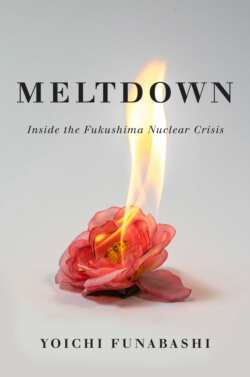Читать книгу Meltdown - Yoichi Funabashi - Страница 23
На сайте Литреса книга снята с продажи.
THREE Hydrogen Explosion PRIME MINISTERIAL INSPECTION OF THE SITE
ОглавлениеIt was in the middle of the night of March 11 that Prime Minister Kan started considering visiting Fukushima Daiichi NPS. First, he thought of a prime ministerial visit to witness the damage wrought by the tsunami. In that case, he would fly out on an air SDF plane from Ichigaya at seven a.m. and return to the Kantei by eleven a.m. However, even though TEPCO said they were going to vent, it still had not been done.
“It is unbelievable venting hasn’t started, with the mighty METI minister and chief cabinet secretary announcing that it would.”
What on earth was going on? Kan was out of patience.
I want to go to the site and see what’s really happening on the ground.
I’m the member of the cabinet who knows his way around nuclear matters best. If I don’t do it, who can?
The words he happened to use were “knows his way around,” and Kan seemed to experience a certain sense of satisfaction with this turn of the phrase.1 Kan’s intention to visit Fukushima solidified by 2:20 a.m.2
Voices were raised in opposition to Kan’s plan to visit Fukushima. Kansei Nakano, chairman of the National Public Safety Commission, quietly expressed his objection, saying that in times of crisis, the political leader should maintain a dignified presence. The Tokyo Police Department, responsible for security, were also against the visit. Nakano passed this on.
When Motohisa Ikeda learned of the “prime ministerial inspection” sometime after four a.m. on March 12, he instinctively felt, It’s not right for the prime minister of the state to come. He contacted NISA Deputy Director General Shinichi Kuroki, and directed him to convey his view to Tokyo.
“It’s better not to come when it’s dangerous … If he does come, he should visit the offsite center at some five kilometers distance, not the actual field site, the Fukushima Daiichi.”
Ikeda’s opinion, however, never reached Kan. Edano had tried to stop Kan when he first learned of the prime minister’s intention.
“It’s a bit early, don’t you think? … It’s a good idea in theory, yes, but politically speaking, you’ll definitely be criticized for going at such a time.”
Kan countered, “Which is more important now? Being possibly criticized later or being in control of the nuclear situation? I’m aware of that.”
“As long as you are aware, then do what you feel is right.”
This was more or less how Edano, too, threw in the towel.
Terada also advised Kan.
“I think it’s better if you stay here, since you are, after all, the prime minister.”
Hosono also felt disturbed about Kan going. For an instant, the thought crossed his mind: What will happen if the prime minister is exposed to radiation?
Would they be able to contact Kan on the helicopter if anything happened? Hosono confirmed that there was a telephone link to the helicopter.
When Takekuro learned of Kan’s intention for a “prime ministerial inspection,” he thought back to the 2007 Chuetsu earthquake and the visit by then Prime Minister Shinzo Abe. Takekuro had been posted at TEPCO’s Kashiwazaki-Kariwa NPS as deputy site superintendent. Abe visited in the middle of the Upper House elections and was criticized for creating confusion. Takekuro, however, remained silent on this question.3
In fact, Kaieda was also thinking that night of visiting the site as the METI minister. On hearing this, however, Fukuyama told Kaieda, “the prime minister is thinking of going,” and urged him to reconsider.
“In that case, I might go with the prime minister.”
“I don’t think that’s a good idea. It’s not good for both of you to be absent.”
After an exchange along these lines, Fukuyama raced over to Edano’s office.
“Chief secretary, please stop Kaieda-san.”
Fukuyama filled him in on the background. Edano rang Kaieda on his mobile phone on the spot and said, “I’d like you to remain this time as the competent minister.” Kaieda abandoned his visit idea.4
Deep down, however, Kan was not sure. When he was alone with Kenichi Shimomura, counselor for public relations at the cabinet secretariat, Kan meekly asked him, “Everyone is against it, but what do you think?”
However, he then went on to say, “A Puma is small and fast. Because it’s so small, I don’t think using it for transportation will create a nuisance.”5
The Puma he was referring to was also known as the Super Puma. It was the SDF’s helicopter for transporting state guests. All of the transportation helicopters were already working at full capacity. It would not do to have them diverted for a prime ministerial inspection. That is why Kan thought if he used the Super Puma, he would not be criticized for obstructing relief operations. In his own way, Kan had taken into account the risks associated with his decision. He made the final decision to visit with only minutes to spare before his six a.m. departure.6
The helicopter arrived at exactly six a.m. on the rooftop helipad at the Kantei. Kan was running a little late.
“Any later and the helicopter won’t be able to take off.”
The helicopter consumed a lot of fuel when it was idling, which would shorten its flight range. Thus urged, Kan jumped on board. He was wearing light blue disaster gear and sneakers.7
